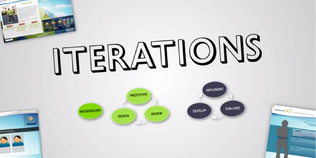Blog
Three Reasons to Love Text in e-Learning
by Ethan Edwards, chief instructional strategist | @ethanaedwards


Be My e-Learning Valentine
By Allen Interactions | February 14, 2011 | Custom Learning | 0 Comments
by Ethan Edwards, chief instructional strategist | @ethanaedwards

Roses are Red,
Violets are Blue,
Carnations are sweet,
And so are you
It’s strange how vivid my childhood memories are of Valentine’s Day in grade school. One day before the holiday, we all prepared by making and decorating a “post box” out of construction paper we’d hang in a row at the bottom of the chalkboard. Then we’d spend the evening at home shuffling through the box of cartoon Valentine cards Mom bought at the Dime Store…perplexed about what to do with the cards that actually suggested a glimmer of sincere romantic feeling…matching ambiguity of affection with the range of friendship shared with the 25 kids in my class…knowing that you couldn’t just skip someone because he or she was a challenge to categorize. And then on Valentine’s Day, opening the cards that got put in my post box, being alternatively embarrassed or amused or hurt depending on who gave me which card, (which were usually the same cards I’d just distributed—after all, everybody’s mom went to the same Dime Store—except for the one show-off who bought the Disney Valentines) while munching heart-shaped cookies and Hawaiian Punch. Even though the day was marked by excitement and vivid experiences, by nightfall, most of my specific memories had faded as completely as my red kool-aid moustache.
 It gets a lot easier to deal with Valentines as we get older and actually have a special someone we relate to with affection. No longer are we burdened with worrying about not overlooking anyone; we can be selfish about our sentiments—saying just what we want without worrying about how it might seem to people unattached to us. Our expressions of affection become part of a greater, more continuous stream of love and support—just one statement in a more important extended conversation. We even feel comfortable splurging on absurdly expensive chocolates or flowers.
It gets a lot easier to deal with Valentines as we get older and actually have a special someone we relate to with affection. No longer are we burdened with worrying about not overlooking anyone; we can be selfish about our sentiments—saying just what we want without worrying about how it might seem to people unattached to us. Our expressions of affection become part of a greater, more continuous stream of love and support—just one statement in a more important extended conversation. We even feel comfortable splurging on absurdly expensive chocolates or flowers.
Unfortunately, many of the inconveniences of childhood Valentine exchanges are what we face in designing instruction for e-learning. We have a huge array of students with whom we need to enter into dialog. Many times we don’t actually know much about them. And the methods we have to communicate are often very limited (you’ve probably heard me claim that no matter how hard you try to avoid it, nearly every e-learning interaction you ever build will be a multiple choice question). And while training is a discipline that requires extended contact, we often are forced to squeeze it into a very concentrated, short burst, funded with inadequate resources, so soon to be forgotten.
But it’s important to remember that the content, challenges, interactions, and reference resources we dole out through our designs are not perceived by the uniform and affectionate judgment of our own eyes, but rather through the diverse perspectives of myriad individual students who take our instruction. They are constrained by rules outside their control, to engage in this ritual, hopefully expectantly, but certainly with some level of doubt. Whether they feel welcome, supported, challenged, and inspired is a function of what we send them in our programs. So as you think about writing content and designing instruction, it helps to think of each of your learners as if they are those children from your childhood, each opening a Valentine, even if mass produced and expected, with his or her name on it, each with a sense that the designer thought of them when constructing the training.
Today I'm asking
If you'll be mine.
Please say “Yes,” readers,
Be my Valentine!
.png?width=135&height=135&name=ai-symbol-green%20(3).png)
About the Author: Allen Interactions
Comments
Would you like to leave a comment?
Related Blog Posts

By: Allen Interactions | Feb, 2016
Category: Custom Learning

Blog
Iterations: 3 Ways to Implement an Elusive Savvy Start
by Ethan Edwards, chief instructional strategist | @ethanaedwards
By: Allen Interactions | Aug, 2014
Category: Custom Learning, Strategic Consulting

Blog
Angry Bird's Implications for m-Learning
by Ethan Edwards, chief instructional strategist | @ethanaedwards
By: Allen Interactions | Mar, 2012
Category: Custom Learning
